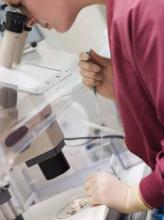LONDON – Children born as a result of assisted conception do not appear to be at any greater cancer risk than children born following spontaneous conception, the results of two large longitudinal studies demonstrated.
A U.K.-based study of more than 100,000 children born after assisted conception between 1992 and 2008 found a lower-than-expected number of cases of cancer, with a standardized incidence rate of 0.98.
Meanwhile the adjusted odds ratio for total cancer risk in a cohort of more than 92,000 Danish, Finnish, and Swedish children born between 1982 and 2007 was 1.15.
The findings of both studies, presented at the annual meeting of the European Society of Human Reproduction and Embryology, are "reassuring," said Dr. Carrie Williams of the Institute for Child Health at University College London.
"This is fantastic news for the 5 million children born after ART [assisted reproductive technology], their families, fertility specialists, and also for [the] wider society," Dr. Williams, who was part of the U.K. study team, added.
"The main driver for our study was parental concern," Dr. Williams explained. "In a study of several hundred families of children born after ART, over a quarter of [parents] had concerns about the health of their child as a result of their method of conception, and many of these concerns [were] related to the overall cancer risk."
Previously, Dr. Williams and her associates performed a systematic review of 11 studies and found that there was a small but significant increase in cancer risk in children born after ART, although the results of one particular study swayed the overall findings (Arch. Dis. Child. 2011;96:A6). The results of another recent meta-analysis of 25 studies also point to a possible increased risk for cancer in children following assisted conception methods (Fertil. Steril. 2013;100:150-61).
A large, population study was needed to examine the issue further, however, and the U.K. team linked data held by the Human Fertilisation and Embryology Authority (HFEA) on births due to ART with the U.K.’s National Registry of Childhood Tumours (NRCT). Over a 16-year study period, there were 106,381 children born in England, Wales, or Scotland after nondonor ART. Of these, 14,896 (14%) developed cancer before their 15th birthday or before Jan. 1, 2009.
The actual data analysis was performed on 106,013 children because the time at risk for the others could not be determined. Standardized incidence rates (SIRs) were calculated for various childhood cancers by determining the observed versus expected rates of each. Potential effect-moderating factors, such as age, sex, birth weight, multiple births, treatment type, and cause of parental infertility, among others, were considered.
The occurrence of most childhood tumors was lower than expected, with SIRs of 0.94 for renal tumors, 0.91 for leukemia, 0.88 for neuroblastoma, 0.85 for central nervous system tumors, 0.59 for retinoblastoma, and 0.56 for germ cell tumors.
"We did find an increased risk of two very rare types of cancer – hepatoblastoma and rhabdomyosarcoma," Dr. Williams reported. SIRs for these tumor types were 3.27 and 2.62, respectively. Further analysis suggested that a lower birth weight (less than 2,500 g) was associated with a 10-fold increase in the risk for hepatoblastoma. No clear explanation could be found for the increased risk for the connective tissue cancer.
"If there is a risk, then the risk is small," said Dr. Anja Pinborg who presented separate data from the Committee on Nordic ART and Safety (CoNARTaS) study, a prospective study involving all children born after assisted conception in Denmark, Finland, and Sweden (Acta. Obstet. Gynecol. Scand. 2011;90:683-91). Data from medical birth, cancer, patient, and cause of death registries were linked to help determine if ART did indeed carry an increased risk for malignancy.
"We show similar results, perhaps a little bit of an increase in the risk for cancer, but not significantly," added Dr. Pinborg of the University of Copenhagen. A total of 178 children were diagnosed with cancer in the cohort after ART, compared with 643 cancer cases in children who were not artificially conceived, giving respective incidence rates of 1.9% vs. 1.7%. Children born after ART were found to be at increased risk for CNS tumors in the Nordic cohort, but the prevalence was 0.4%.
"It’s very important to underline that the control population of parents differs from the ART population of parents because the mothers are older and they are reproductively healthy," Dr. Pinborg noted. People can be helped to conceive a child, but the underlying cause of the infertility usually cannot be resolved, she said, suggesting subfertility per se might play a role.


